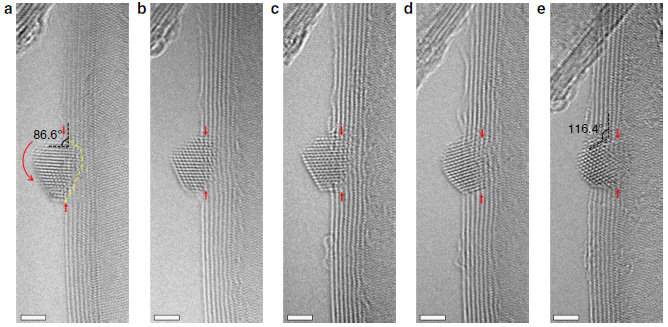Instrument Used
The model 628 from Gatan is a furnace-type holder designed to facilitate direct observation of microstructural phase changes, nucleation, growth, catalysis and dissolution processes in 3 mm TEM samples at heightened temperatures.
Background
Heterogeneous catalysis is vital within a range of clean energy technology applications, such as the reduction of soot emissions. During heterogeneous catalysis, reactants are converted into products on the surface of a solid catalyst material. Recent development of catalyst materials usually focuses on nanoparticles (NP) because these have a significant surface-to-volume ratio.
Ag has been the subject of considerable research for oxidation of carbonaceous materials like soot. These studies aim to explore the atomic structure of Ag nanoparticle active sites for carbon oxidation via multi-walled carbon nanotubes (MW-CNT) - a model carbonaceous material.
Materials and Methods
Gatan’s model 628 heating holder was utilized inside of an aberration-corrected environmental TEM (AC-TEM) to achieve an elevated temperature within an O2 environment. This process was not recorded by video, in order to keep the electron beam exposure as low as possible.
An UltraScan® camera was used to obtain single frame images with the sample at 250 °C. The oxygen was removed in order to prevent ionization damage. A number of these images are shown in Figure 1.

Figure 1. Series of AC-ETEM images during nanotube oxidation. The oxidation reaction was conducted at 250 °C in 2 mbar O2 images were acquired after: (a) 0 s, (b) 300 s, (c) 600 s, (d) 900 s, and (e) 1,800 s. The two dashed black lines in a) mark the angle between the Ag NP/MW-CNT system, which was used to monitor the rotation of the Ag NP. The curved red arrow denotes the rotation direction, and the
yellow dashed line marks the contact interface between the Ag NP and the MW-CNT. Scale bars are 2 nm. Small red arrows indicate the depth to which the oxidation has reached. The turnover frequency of the Ag NP sites on this single particle could be directly determined from these images. Yue, Y., Yuchi, D., Guan, P., Xu, J., Guo, L., Liu, J., 2016. Atomic scale observation of oxygen delivery during silver-oxygen nanoparticle catalyzed oxidation of carbon nanotubes. Nature Communications 7, 12251. doi:10.1038/ncomms12251. Image Credit: Gatan.
Summary
In-situ observation of Ag nanoparticles catalyzing the oxidation of carbon nanotubes was made possible through the use of a model 628 heating holder in an aberration-corrected ETEM.
The high-resolution images of the catalyst particle at various points in the tube oxidation allowed for the quantification of the turnover frequency for this single nanoparticle. First-principles simulations guided by these observations indicated a Mars-van Krevelen type mechanism, whereby oxygen is dissociated on the Ag surface, diffusing through the Ag NP and reaching the MW-CNT surface.
Credits
A special thanks to: Yonghai Yue, ASU, BUAA; Datong Yuchi, ASU; Pengfei Guan, CSRC; Jia Xu, ASU; Lin Guo, BUAA; Jingyue Liu, ASU.

This information has been sourced, reviewed and adapted from materials provided by Gatan, Inc.
For more information on this source, please visit Gatan, Inc.